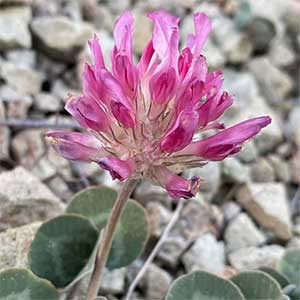Trifolium owyheense
Trifolium longipes
Owyhee clover
long-stalk clover
cespitose, spreading, branched proximally, sparsely branched distally.
erect or ascending, cespitose, unbranched to sparsely branched distally.
palmate;
stipules broadly obovate, 1–2 cm, fused at base, margins slightly lobed, apex acute;
petiole 2–6 cm;
petiolules 1–1.5 mm;
leaflets 3, blades ovate, obovate, or orbiculate, slightly overlapping, 1–2 × 0.7–2.3 cm, base truncate to rounded, veins prominent, margins sparsely dentate, apex rounded, emarginate, surfaces glabrous.
palmate;
stipules ovate to lanceolate, 1–5 cm, margins usually entire, sometimes slightly serrate proximally, apex acute or acuminate;
petiole 1–13 cm;
petiolules to 1 mm;
leaflets 3, blades linear, lanceolate to elliptic, or oblong, cauline sometimes ovate, 0.8–6 × 0.2–1.6 cm, base cuneate, veins slightly to very thickened, arching, margins entire or serrate, apex acute, surfaces glabrous abaxially, usually appressed-pubescent adaxially.
terminal, 20–30-flowered, globose, usually formed of 2 sessile heads, 2.5–5 × 2.5–5 cm;
involucres absent.
terminal, 10–40-flowered, globose, ellipsoid, obconic, or subglobose, 1–3.5 × 1–3.2 cm;
involucres absent.
3–7 cm, surpassing subtending leaves.
1–30 cm.
erect, reflexed in proximalmost flowers, 1 mm;
bracteoles cuplike, 0.5 mm.
erect or reflexed in fruit, 0.5–2 mm;
bracteoles scalelike, 0.5 mm.
15–21 mm;
calyx tubular-campanulate, 9–12 mm, pilose, veins 10, tube 4.5–6 mm, lobes subequal, abaxialmost longest, subulate, orifice open;
corolla deep pink or magenta, 20–23 mm, banner tubular for most their length, 18–22 × 5–7 mm, apex flared.
10–19 mm;
calyx tubular, 4–10 mm, hairy or glabrous, veins 5–10, tube 2.5–3 mm, lobes unequal, linear, shorter than or to 6 times tube, orifice open;
corolla white, cream, pink, lavender, or purple, sometimes pale with purple tips, 10–18 mm, petals not beaked except subsp. multipedunculatum, banner ovate to oblanceolate, 10–18 × 3–4 mm, apex usually not beaked, usually obtuse, acute, or acuminate, rarely emarginate;
ovaries pubescent distally.
ellipsoid, 4–5 mm.
oblong to ellipsoid, 4–5 mm.
1 or 2, yellow-mottled, mitten-shaped, 2–3 mm, smooth.
1–4, dark brown, flattened globose, 2–3 mm, smooth.
Trifolium owyheense
Trifolium longipes
Trifolium owyheense is known from about 40 populations in a small portion of east-central Malheur County in Oregon, and immediately adjacent Owyhee County in Idaho (M. Mancuso 2001).
(Discussion copyrighted by Flora of North America; reprinted with permission.)
Subspecies 12 (12 in the flora).
Trifolium longipes encompasses a morphologically diverse and taxonomically difficult suite of populations. J. M. Gillett (1969) united T. longipes with T. rusbyi and differentiated ten subspecies, with T. neurophyllum recognized as distinct. M. Zohary and D. Heller (1984) maintained T. rusbyi (with seven subspecies, including subsp. neurophyllum) as distinct from T. longipes (with five subspecies). Analyses of molecular data support the union of T. longipes and T. rusbyi (N. W. Ellison et al. 2006).
(Discussion copyrighted by Flora of North America; reprinted with permission.)
1. Banner, wing, and, often, keel petals beaked. | subsp. multipedunculatum |
1. Banner, wing, and keel petals without beaks, banner apex acute to attenuate. | → 2 |
2. Pedicels erect or proximalmost horizontal or slightly reflexed in fruit. | → 3 |
3. Herbs rhizomatous; roots not fusiform, sometimes thickened. | → 4 |
4. Calyx lobes lax, usually slightly longer than tube length, tube veins not prominent; leaflet blades lanceolate, elliptic to oblong, or ovate. | subsp. hansenii |
4. Calyx lobes often ± rigid, 6 times tube length, tube veins usually prominent; leaflet blades linear to elliptic-linear or broadly elliptic. | subsp. elmeri |
3. Herbs not rhizomatous (stems ascending from crowns); roots thickened, often fusiform. | → 5 |
5. Banner and wing apices slender-acuminate. | subsp. longipes |
5. Banner and wing apices usually acute or obtuse, rarely emarginate. | → 6 |
6. Calyces and distal ends of peduncles densely pilose; banner apex acute. | subsp. atrorubens |
6. Calyces and distal ends of peduncles sparsely pilose or glabrous; banner apex usually broad, acute or obtuse, rarely emarginate. | subsp. pedunculatum |
2. Pedicels (at least proximal ones, usually all), strongly reflexed in fruit. | → 7 |
7. Herbs with thickened roots, often fusiform, with crown of buried stems. | subsp. pygmaeum |
7. Herbs usually rhizomatous, if rarely with roots ± thickened, then with crown of rhizomes above thickened portion, or with slender taproots bearing a crown of wiry, pilose stems. | → 8 |
8. Pedicels slender, 1.5–2 mm; herbs with slender taproots, bearing crown of wiry, pilose stems. | subsp. oreganum |
8. Pedicels stout, to 1 mm; herbs rhizomatous. | → 9 |
9. Inflorescences globose or ellipsoid; proximal pedicels more strongly reflexed than distal ones. | → 10 |
10. Inflorescences 18–22-flowered, globose, 2.2–2.5 cm diam.; flowers 10–13 mm, corollas purple, sometimes tips white. | subsp. shastense |
10. Inflorescences 28–32-flowered, ellipsoid, 3–3.2 cm diam.; flowers 14–16 mm, corollas lavender. | subsp. caurinum |
9. Inflorescences hemispheric, obconic, or subglobose; all pedicels strongly reflexed. | → 11 |
11. Calyces sparsely pilose or curly-pilose at sinuses, often glabrous proximally; corollas white, cream, or violet. | subsp. reflexum |
11. Calyces white-villous, veins and lobes green; corollas purple-violet or lavender. | subsp. neurophyllum |


